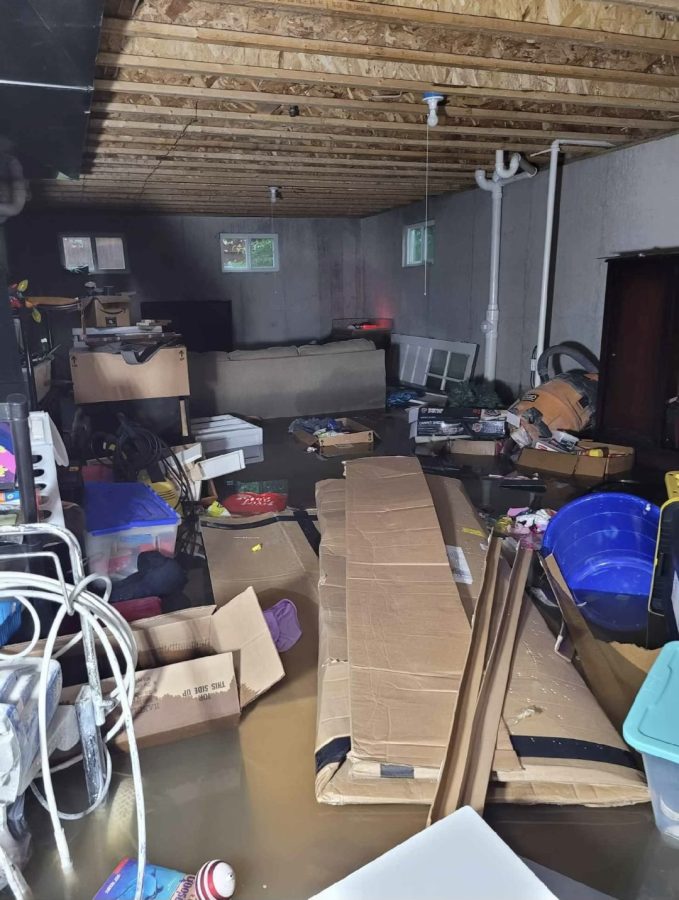Record Breaking July Rainfall Leads to Floods
Courtney Fox’s (10) basement flooded with 22 inches of standstill water. These floodings resulted in damages to over 750 homes, 130 businesses and led to at least $35 million in damage to uninsured buildings and emergency response costs.
November 25, 2022
It was a dark and stormy night at 9 p.m. on July 25 as rainstorms began forming in the St. Louis area. Thunder became louder and more frequent and so did the radar and flood warnings. With temperatures in the upper 90s and low 100s, the drop to the lower 80s overnight wasn’t the only drastic change.
The previous record for rain in St. Louis within 24 hours was set in 1915 at 7.02 inches, which was broken in just six hours on July 26, 2022, with 7.68 inches.
However, it continued to pour into 8.64 inches at St. Louis-Lambert International Airport. 25% of the yearly average rainfall fell in just 12 hours, laying at an overall maximum of 12.86 inches in St. Peters.
Spanning over 100 miles from Columbia, Missouri to Waterloo, Illinois, an average of over 8 inches of rain was recorded in the late hours of July 25 to midday on July 26.
According to weather.gov, in the six-hour period, over 7 inches of rain fell, which statistically has a 1 in 1000 chance of occurring in a given year.
Man-made structures in the middle of the country aren’t designed to withstand hours of pouring rain, humid air, and strong winds like on the coasts. Hundreds of homes, businesses, roads, and buildings were flooded, rotted, and destroyed in this record-breaking storm.
Having been in the middle of renovations, science teacher Samuel Berendzen’s home was affected by the floods.
“We had two major things happen. One is that the roof of our house got torn open, so water came inside, and then water got into our basement,” Berendzen said. “Water in the basement is water in the basement and the upstairs water ended up having to have our walls and ceilings torn out. Our contractor said it would be roughly around 150,000 dollars to repair the interior walls, roof, and basement.”
Sophomore Courtney Fox’s home also experienced damage.
“Our basement had 22 inches of water in it because the drains were backed up because where they let out outside was also flooded,” Fox said. “We had to throw away nearly everything down there and fix anything that we haven’t replaced. The cost is over 20,000 dollars to fix the structure and support.”
Aside from the physical and financial damages, both experienced mental and emotional changes as well.
“The damages were awful,” Fox said. “Everything on our basement floor was soaked and had water damage. We have a lot of belongings that we lost, like all of my sisters and I’s childhood toys, photos from when my mom was younger, and tons of documents. We also lost all of the furniture that we had down there.”
For Berendzen and his family, their lives have “taken an unexpected turn.”
“We’ve lived in a hotel for 54 days and we just moved into an apartment so hopefully, we’ll stay in the apartment until the house is done and we can move back in,” Berendzen said.
The instability of living conditions in consequence of the floods has only contributed to the unstableness of the past few years.
“I’ve been very behind at school and not giving my students the attention that they deserve and I feel terrible,” Berendzen said. “It’s also been very challenging to live in a hotel, which is pretty much the definition of homeless. And to try to be able to come to work every day has been just emotionally draining.”
Even though these floods have ended, their damages haven’t been forgotten. Since damages can be fixed, soon, the record books and missing items will be the only visual evidence that these floods even happened. The damages in Florida with Hurricane Ian, however, will leave a permanent stain on the citizens of Florida, South Carolina, and North Carolina.


